I'm trying to implement an N body simulation in C# using either Runge Kutta 4 or Velocity Verlet integration algorithms.
Before I move to a bigger number of particles, I wanted to test the simulation by modeling the earth's orbit around the sun, however, instead of the elliptical orbit, I get a weird spiral for some reason.
I can't figure out the problem since I made a simpler simulation of the solar system using the same algorithms where the sun was fixed in position and everything worked perfectly. The integrators work perfectly because it doesn't matter which one I use, I get the spiral with both.
Any help would be appreciated.
Here's the code:
class NBODY
{
public static double G = 4 * Math.PI * Math.PI;
class Particle
{
public double[] r; // position vector
public double[] v; // velocity vector
public double mass;
//constructor
public Particle() {}
public Particle(double x, double y, double z, double vx, double vy, double vz, double m)
{
this.r = new double[3];
this.v = new double[3];
this.r[0] = x;
this.r[1] = y;
this.r[2] = z;
this.v[0] = vx;
this.v[1] = vy;
this.v[2] = vz;
this.mass = m;
}
public void Update(Particle[] particles, double t, double h, int particleNumber)
{
RungeKutta4(particles, t, h, particleNumber);
}
private double acc(double r, Particle[] particles, int particleNumber, double[] r_temp, int l)
{
// dv/dt = f(x) = -G * m_i * (x - x_i) / [(x - x_i)^2 + (y - y_i)^2 + (z - z_i)^2]^(3/2)
double sum = 0;
switch (l)
{
case 0:
for (int i = 0; i < particles.Length; i++)
if (i != particleNumber)
sum += particles[i].mass * (r - particles[i].r[l]) / Math.Pow( Math.Pow(r - particles[i].r[l], 2)
+ Math.Pow(r_temp[1] - particles[i].r[1], 2) + Math.Pow(r_temp[2] - particles[i].r[2], 2), 1.5);
break;
case 1:
for (int i = 0; i < particles.Length; i++)
if (i != particleNumber)
sum += particles[i].mass * (r - particles[i].r[l]) / Math.Pow(Math.Pow(r - particles[i].r[l], 2)
+ Math.Pow(r_temp[0] - particles[i].r[0], 2) + Math.Pow(r_temp[2] - particles[i].r[2], 2), 1.5);
break;
case 2:
for (int i = 0; i < particles.Length; i++)
if (i != particleNumber)
sum += particles[i].mass * (r - particles[i].r[l]) / Math.Pow(Math.Pow(r - particles[i].r[l], 2)
+ Math.Pow(r_temp[0] - particles[i].r[0], 2) + Math.Pow(r_temp[1] - particles[i].r[1], 2), 1.5);
break;
}
return -G * sum;
}
private void RungeKutta4(Particle[] particles, double t, double h, int particleNumber)
{
//current position of the particle is saved in a vector
double[] r_temp = new double[3];
for (int j = 0; j < 3; j++)
r_temp[j] = this.r[j];
//loop going over all the coordinates and updating each using RK4 algorithm
for (int l = 0; l < 3; l++)
{
double[,] k = new double[4, 2];
k[0, 0] = this.v[l]; //k1_r
k[0, 1] = acc(this.r[l], particles, particleNumber, r_temp, l); //k1_v
k[1, 0] = this.v[l] + k[0, 1] * 0.5 * h; //k2_r
k[1, 1] = acc(this.r[l] + k[0, 0] * 0.5 * h, particles, particleNumber, r_temp, l); //k2_v
k[2, 0] = this.v[l] + k[1, 1] * 0.5 * h; //k3_r
k[2, 1] = acc(this.r[l] + k[1, 0] * 0.5 * h, particles, particleNumber, r_temp, l); //k3_v
k[3, 0] = this.v[l] + k[2, 1] * h; //k4_r
k[3, 1] = acc(this.r[l] + k[2, 0] * h, particles, particleNumber, r_temp, l); //k4_v
this.r[l] += (h / 6.0) * (k[0, 0] + 2 * k[1, 0] + 2 * k[2, 0] + k[3, 0]);
this.v[l] += (h / 6.0) * (k[0, 1] + 2 * k[1, 1] + 2 * k[2, 1] + k[3, 1]);
}
}
/*
Velocity Verlet algorithm:
1. Calculate y(t+h) = y(t) + v(t)h + 0.5a(t)h*h
2. Derive a(t+h) from dv/dt = -y using y(t+h)
3. Calculate v(t+h) = v(t) + 0.5*(a(t) + a(t+h))*h
*/
private void VelocityVerlet(Particle[] particles, double t, double h, int particleNumber)
{
double[] r_temp = new double[3];
for (int j = 0; j < 3; j++)
r_temp[j] = this.r[j];
//loop going over all the coordinates and updating each using RK4 algorithm
for (int l = 0; l < 3; l++)
{
//position
this.r[l] += h * this.v[l] + 0.5 * h * h * acc(this.r[l], particles, particleNumber, r_temp, l);
//velocity
this.v[l] += 0.5 * h * (acc(r_temp[l], particles, particleNumber, r_temp,l)
+ acc(this.r[l], particles, particleNumber, r_temp,l));
}
}
}
static void Main(string[] args)
{
//output file
TextWriter output = new StreamWriter("ispis.txt");
// declarations of variables
Particle[] particles = new Particle[2];
particles[0] = new Particle(0, 0, 0, 0, 0, 0, 1); //sun
particles[1] = new Particle(1, 0, 0, 0, 6.28, 0, 3.003467E-06); //earth
int N = 200;
double h, t, tmax;
double[,,] x = new double[particles.Length, N, 3]; //output
// setting initial values, step size and max time tmax
h = 0.01; // the step size in years
tmax = h * N;
// initial time
t = 0;
int i = 0;
while (t <= tmax) {
//updates position of all particles
for (int z = 1; z < particles.Length; z++)
particles[z].Update(particles, t, h, z);
//saves the position for output
for (int j = 1; j < particles.Length ; j++)
for (int z = 0; z < 3; z++ )
x[j,i,z] = particles[j].r[z];
t += h;
i++;
}
//output to file
for (int k = 0; k < particles.Length; k++ )
{
for (int f = 0; f < 3; f++)
{
for (int l = 0; l < N; l++)
output.Write(string.Format("{0,-15:0.########},", x[k,l,f]));
output.Write(string.Format("\n\n"));
}
output.Write(string.Format("\n\n\n\n"));
}
output.Close();
}
}
And here's the plot of the output data for earth's orbit:
